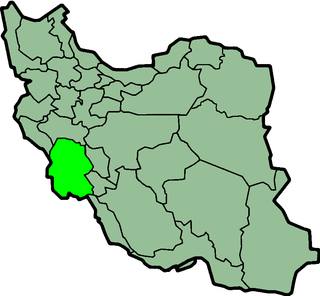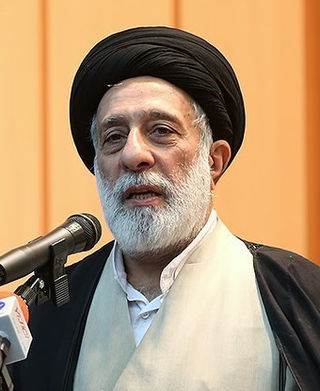
Azerbaijanis, Azeris, or Azerbaijani Turks are a Turkic ethnic group living mainly in the Azerbaijan region of northwestern Iran and the Republic of Azerbaijan. They are predominantly Shia Muslims. They comprise the largest ethnic group in the Republic of Azerbaijan and the second-largest ethnic group in neighboring Iran and Georgia. They speak the Azerbaijani language, belonging to the Oghuz branch of the Turkic languages.
This article focuses on the status of ethnic minorities in contemporary Iran.

Pan-Turkism or Turkism is a political movement that emerged during the 1880s among Turkic intellectuals who lived in the Russian region of Kazan (Tatarstan), Caucasus and the Ottoman Empire, with its aim being the cultural and political unification of all Turkic peoples. Turanism is a closely related movement but it is a more general term, because Turkism only applies to Turkic peoples. However, researchers and politicians who are steeped in the pan-Turkic ideology have used these terms interchangeably in many sources and works of literature.
Pan-Iranism is an ideology that advocates solidarity and reunification of Iranian peoples living in the Iranian plateau and other regions that have significant Iranian cultural influence.

Khuzestan province is a petroleum-rich, ethnically-diverse province in southwestern Iran. Oil fields in the province include Ahvaz Field, Marun, Aghajari, Karanj, Shadegan and Mansouri. Amnesty International has voiced human-rights concerns about Khuzestan's Arab population, and United Nations special rapporteur Miloon Kothari has also drawn attention to Arab displacement and poverty among the Laks.

Mohsen Sazegara calls himself as Iranian journalist and pro-democracy political activist. He was the founder of IRGC after the revolution in 1979. He held several offices in the Government of Mir-Hossein Mousavi. He applied to become a candidate for President of Iran in the 2001 election but was declined.

Sayyid Hadi Khamenei is an Iranian reformist politician, mujtahid and linguist. He is a key member of the reformist Association of Combatant Clerics, and a former deputy of the Majlis of Iran representing a district in Tehran.
Anti-Iranian sentiment, also known as Anti-Persian sentiment, Persophobia, or Iranophobia, is feelings and expression of hostility, hatred, discrimination, or prejudice towards Iran and its culture and towards persons based on their association with Iran and Iranian culture. Its opposite is Persophilia.

Mana Neyestani is an Iranian cartoonist, illustrator, and comic book creator. His work appears internationally in economic, intellectual, political and cultural magazines. He is particularly known for his work for reformist papers in Iran and Persian language websites Radio Zamaneh, Tavaana: E-Learning Institute for Iranian Civil Society, and IranWire. He is also well-known because of his cartoons about Iranian presidential election, 2009. He is the 2010 recipient of the Cartoonists Rights Network International Award for Courage in Editorial Cartooning. He lives in France.

Mahmudali Chehregani is an Iranian Azerbaijani political activist, born in Shabestar, East Azarbaijan Province, Iran, in 1958. After the expulsion of the South Azerbaijan National Liberation Movement) by Piruz Dilenchi, he founded the Southern Azerbaijan National Awakening Movement, a political group that claims to represent the interests of Iran's estimated 12 to 18.5 million Azerbaijani minority. Chehregani was a professor of linguistics at Tabriz University.
Islamic Revolutionary Court is a special system of courts in the Islamic Republic of Iran designed to try those suspected of crimes such as smuggling, blaspheming, inciting violence or trying to overthrow the Islamic government. The court started its work after the 1979 Iranian Revolution.
Persianization or Persification, is a sociological process of cultural change in which a non-Persian society becomes "Persianate", meaning it either directly adopts or becomes strongly influenced by the Persian language, culture, literature, art, music, and identity as well as other socio-cultural factors. It is a specific form of cultural assimilation that often includes a language shift. The term applies not only to cultures, but also to individuals, as they acclimate to Persian culture and become "Persianized" or "Persified".

Official diplomatic relations between the Republic of Azerbaijan and the Islamic Republic of Iran were established following the dissolution of the Soviet Union (1991). Iran and Azerbaijan share, to a large extent, the same history, religion, and culture. The territory of what is now called the Republic of Azerbaijan was only separated from Iran in the first half of the 19th century, through the Russo-Persian Wars. In the area to the North of the river Aras, the territory of the contemporary Republic of Azerbaijan was Iranian territory until it was occupied by Russia. Iran and Azerbaijan are both majority Shia Muslim nations. They have respectively the highest and second highest Shia population percentage in the world, as well as the history of Shi'ism which is rooted in both nations from exactly the same moment in history, whereas the majority of the population of both their neighboring nations are either predominantly Christians or Sunni Muslims. However, there are some tensions between the two countries as its political alignment may vary by degree. The Republic of Azerbaijan has become increasingly pro-Western aligned, and is an ally of Israel, Turkey and the United States while the Islamic Republic of Iran is largely pro-Russian and pro-Chinese aligned due to its hostility towards the U.S. and has been targeted with sanctions. Iranian politicians, like Mohammad Hosseini, have called Azerbaijan an Israeli proxy.

Iranian Azerbaijanis are Iranians of Azerbaijani ethnicity. Most Iranian Azerbaijanis are bilingual in Azerbaijani and Persian. They are mainly of Iranian descent. They are primarily found in and are native to the Iranian Azerbaijan region including provinces of and in smaller numbers, in other provinces such as Kurdistan, Qazvin, Hamadan, Gilan, Markazi and Kermanshah. Iranian Azerbaijanis also constitute a significant minority in Tehran, Karaj and other regions.

2005 Ahvaz unrest or 15 April Ahvaz Protests were violent riots, initiated by Iranian Arabs in the city of Ahvaz in southwestern Iranian province of Khuzestan. The unrest erupted on 15 April 2005, and lasted for 4 days. Initially, the Iranian Interior Ministry stated that only one person had been killed, however an official at a hospital in Ahvaz said that there were between 15 and 20 mortal casualties. Government officials blamed the unrest on Britain, whose troops based just across the border in southern Iraq. Following the unrest, several bombings were carried out in Ahvaz, killing 28 people. In 2006, Iran executed five Arab separatists, convicted of carrying out the bombings in 2005.
Shireen Tahmaaseb Hunter is an independent scholar. Until 2019, she was a Research Professor at the Center for Muslim-Christian Understanding (ACMCU) at Georgetown University in Washington, D.C., with which she had been associated since 2005, as Visiting Fellow and then Visiting Professor. She became an honorary fellow of ACMCU in September 2019.
The anti-Azerbaijani sentiment, or anti-Azerbaijanism has been mainly rooted in several countries, most notably in Armenia and Iran, where anti-Azerbaijani sentiment has sometimes led to violent ethnic incidents.
The Fitilieh programme protests started on 9 November 2015 after a segment of the children's television programme Fitileh, aired on 6 November on local state TV, depicted an Azeri speaking Iranian brushing his teeth with a toilet brush.

GünAz TV is an Azerbaijani-language television channel based in Chicago and broadcasting in Europe, West Asia, North Africa, and Central Asia. It is run by Ahmad Obali, who founded it in 2004. Ideologically, the television channel promotes a pan-Turkist viewpoint and supports ethnic Azerbaijani separatism in Iran.












